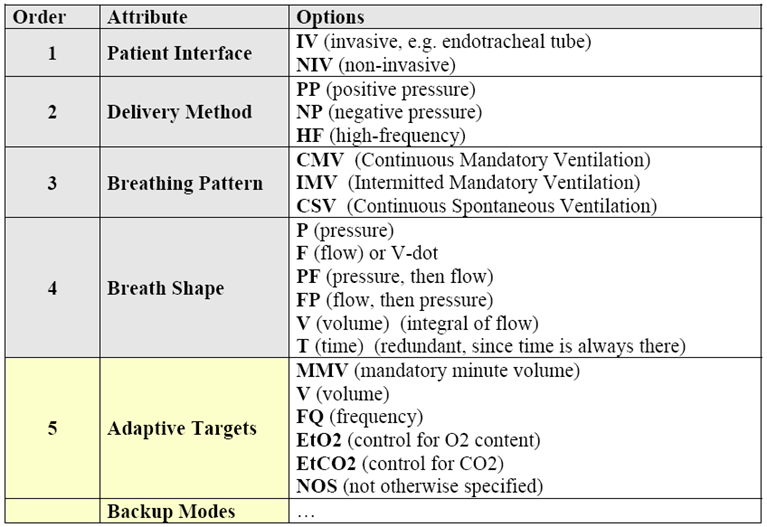Difference between revisions of "PCD RTM Vent Modes"
ToddCooper (talk | contribs) m (→Ventilator Operational Mode Semantic Model: Extended structure of table...) |
m (→Mode Issues List: Mark's PF/PV question) |
||
| Line 108: | Line 108: | ||
| Breath Shape | | Breath Shape | ||
| PF or is it really PV? | | PF or is it really PV? | ||
| − | | ''''' | + | | '''''Mark wanted to know if the BREATH SHAPE item should be classified as Pressure-Flow or Pressure-Volume. In his opinion, in a volume assured breath, you set the pressure, then maintain it until you reach the assured volume-Joel''''' |
| . | | . | ||
|- | |- | ||
| Line 118: | Line 118: | ||
| . | | . | ||
|} | |} | ||
| − | |||
== Mode Mapping Sandboxes == | == Mode Mapping Sandboxes == | ||
Revision as of 13:25, 30 May 2008
Ventilator Operational Mode Semantic Model
A key item in the Vent TG's discussion is to identify the core semantic components that make up a ventilator's operational modality. This in turn can be used to organize a device's settings, waveform annotations, etc. It is understood that the actual labels associated to a given mode will vary from vendor's device to device, and should eventually be harmonized with related activities such as the work being done within ISO TC121/SC 3/JWG 1 (Joint with IEC/SC62D) Critical Care Ventilators. Component semantics should be flexible enough to support all of these usages, though.
Note: This is also intended to result in an update to the existing ventilator operational modality terminology standard contained in ISO/IEEE 11073-10101 Health informatics - Point-of-care medical device communication - Nomenclature document.
The following table illustrates the current model being proposed:
| Atrribute | Description | Discussion |
|---|---|---|
| Patient Interface | <general semantic attribute description>
|
... |
| Delivery Method | <general semantic attribute description>
|
... |
| Breathing Pattern | <general semantic attribute description>
|
... |
| Breath Shape | <general semantic attribute description>
|
|
| Adaptive Targets | <general semantic attribute description>
|
... |
| Assist Augmentation | <general semantic attribute description>
|
Note: During the 2008-05-15 WebEx it was decided to add another Attribute to this table - "Assist/Support Breath Augmentation" (final name TBD). |
Reference Documents
- <add references to documents that are related to this vent mode analysis>
Mode Issues List
The following table captures the current issues that need to be resolved regarding the above model:
Item Submitters Attr Topic Description Discussion/Disposition 1 Berryhill Breath Shape PF or is it really PV? Mark wanted to know if the BREATH SHAPE item should be classified as Pressure-Flow or Pressure-Volume. In his opinion, in a volume assured breath, you set the pressure, then maintain it until you reach the assured volume-Joel . 2 tbd . . . .
Mode Mapping Sandboxes
The table below may be used to try out mapping specific vent modes (real modes provided on real vents!) and to discuss issues with the model above - gaps, adjustments, etc.
NOTE: A sample table has been provided - copy that heading and table and then use it as a sandbox for your own mappings.
Mode Sandbox Table: (Sample)
Mode Name P/I D/M B/P B/S A/T B/M Description/Notes High Freq IV HF n/a n/a n/a n/a ... tbd tbd tbd . . . . ...
